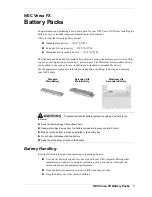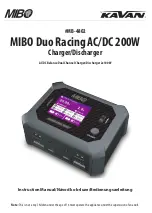
2
Bulk
continued
internal charge capacity. The charger current is flat (constant)
and the battery voltage is rising.
Maximum allowable charge voltage & current allowed by
the battery manufacturer should be used to ensure the most
energy is returned within the bulk stage.
Bulk Charge Stage Time Calculation:
Max Time (Hr) = (Ahr x 1.2)/Avg. Current (A)
Ahr = Amp hours removed during discharge.
1.2 = Recharge multiplier
Avg. Current = Average current available
to battery from charger.
Note: Avg. current should be < maximum current limits
for installed battery. Charge current limits available
from your East Penn representative.
Max Time (Hr) – Maximum charge time for battery to
reach 80% - 85% state of charge
Absorption
The charger will attempt to hold its output voltage constant
while the battery continues to absorb charge (draw charging
current) from the charger. The rate at which the battery con-
tinues to absorb charge in this mode gradually slows down.
The amplitude of the charger current is gradually decreasing.
The charge current is falling and the battery voltage is flat
(constant).
Some Inverter/Charge Controllers can either use time or
current to determine the length of the absorption stage.
Time regulated absorption
is based on a predetermined time
after the battery has completed the bulk stage (charge voltage
has reached its maximum set point). A lead-acid battery is said
to be at 80% to 85% SOC (State of Charge) when the voltage
set point is met and the current starts to taper; considered the
start of absorption. The remaining time required to reach
100% SOC is based on ever changing factors: solar isolation
(summer vs. winter), ambient temperature, battery type
(flooded, VRLA), and battery age.
Absorption stage time should be set to optimize the available
sun hours during the winter and/or cloudy months. If improp-
erly set, there is a risk of undercharging the battery system.
It is recommended to set the absorption time to the maxi-
mum time setting possible to take advantage of all available
charging light regardless of time of year or weather issues.
Using this method, the sun availability will determine the
absorption time. Following this recommendation, there is no
risk of overcharging if the battery charge voltage is set within
the recommended settings.
The amount of available power (current) to the batteries is
important for getting a battery charged. Available power
(current) to the batteries is the remaining power (current) after
connected loads are satisfied. Maximum charge voltage and
current allowed by the battery manufacturer should be used to
ensure the most energy is returned to the batteries.
The below calculation will assist in identifying the necessary
maximum charge current for the system. If the calculation
shows the absorption time is greater than the minimum
average peak sun hours for the installation location, the
amount of available current to the batteries should be
increased, which could be accomplished by a larger array
or a secondary power source such as a generator.
Charge Current Verification:
FLOODED
C20 x 0.44/charge current available
Example:
Maximum Charge Current
Battery Rating: 1186Ah (C20)
237A – Charge current (maximum)
1186Ah x 0.44 / 237 = 2.20 hrs
Minimum Charge Current
Battery Rating: 1186Ah (C20)
118A – Charge Current (minimum)
1186Ah x 0.44 / 118A = 4.42 hrs
VRLA (AGM & GEL)
C20 x 0.39/charge current available
Example:
Maximum Charge Current
Battery Rating: 183Ah (C20)
55A – Charge current (maximum)
183Ah x 0.39 / 55A = 1.30 hrs
Minimum Charge Current
Battery Rating: 183Ah (C20)
18.3A – Charge Current (minimum)
183Ah x 0.39 / 18.3A = 3.90 hrs
Current regulated absorption
is using the charge current
to determine battery state of charge, which eliminates a
majority of the variables previously mentioned with time
based absorption (solar isolation, ambient temperature,
battery type). Charging in constant voltage, when a
battery/battery system reaches the absorption voltage setting
the current will start to taper. The point at which the current
stops tapering or declining is referred to as the stabilizing
current. This is an indication that the battery is fully charged
and the current the battery/battery system is drawing is only
needed to keep the battery at the set voltage. This minimum
or stabilizing current will change based on the charge voltage
setting. Battery manufacturer should be consulted for current
settings.
An additional option for determining the SOC of a battery is
monitoring the Ah (amp hour) removed from a battery
during a discharge and the amount of Ah returned during
charge; similar to a gas gauge in a car. The Ah in and out
should be monitored on a continuous basis to keep track of
the overall SOC not just from day to day.
Float
The voltage at which the battery is maintained after being
charged to 100% SOC (State of Charge) to maintain capacity
by compensating for self-discharge of the battery.
Equalize
A charge, at a level higher than the normal float voltage,
applied for a limited period of time, to correct inequalities of
voltage, specific gravity, or state of charge that may have
developed between the cells during service.
Note: Equalize charging not required on VRLA (AGM/Gel)
as part of a daily charge setup. Based on PV applications,
unpredictable recharge availability, periodic equalize may
be required.
Содержание Deka SOLAR
Страница 1: ...Renewable Energy Technical Manual ...
Страница 9: ...7 APPENDIX B Example of typical 3 stage charger ...




























